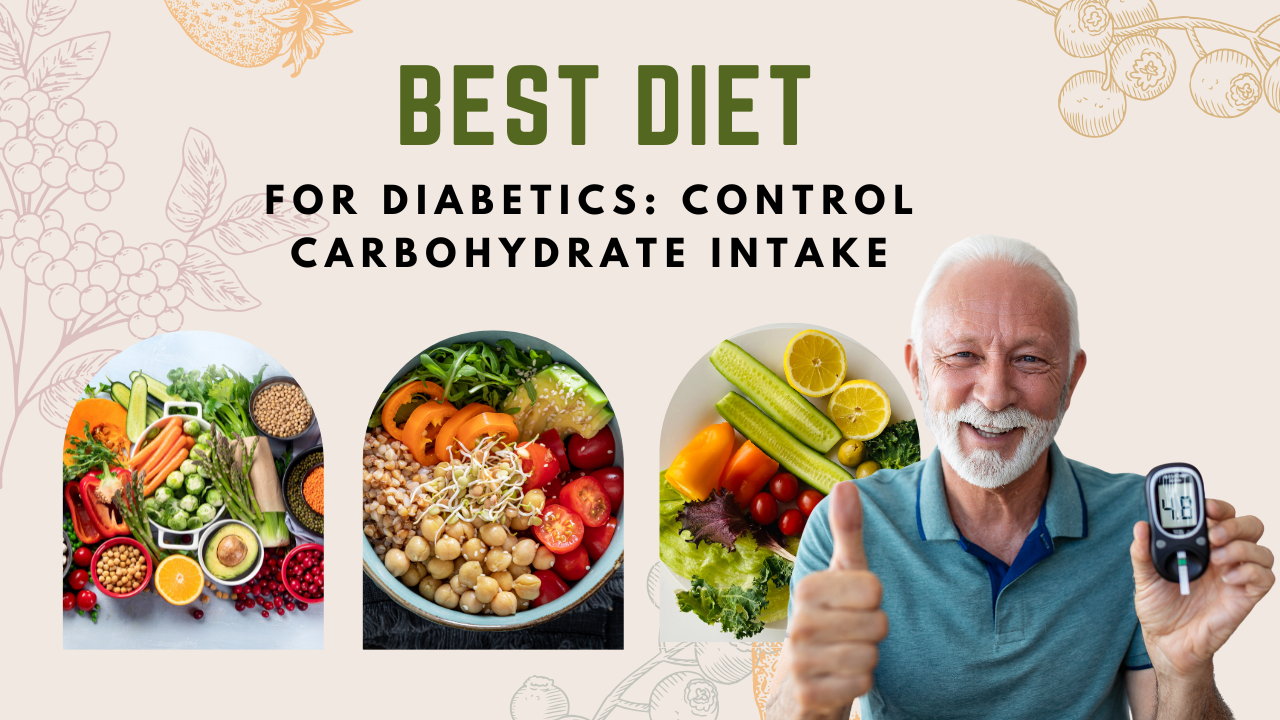The digestive system is a vital network of organs and glands that work together to break down food, absorb nutrients, and remove waste. This process begins the moment food enters the mouth, where mechanical chewing and saliva start digestion. As food travels through the esophagus into the stomach, it is further broken down by stomach acids and enzymes.
Once in the small intestine, the digestive system continues to work by absorbing essential nutrients into the bloodstream. The liver, pancreas, and gallbladder release additional substances that support digestion and nutrient absorption. This phase ensures the body receives the energy and materials it needs for growth, repair, and daily functioning.
Finally, the leftover waste moves into the large intestine, where water is absorbed before it exits the body. Understanding how the digestive system functions is key to maintaining good health, preventing digestive disorders, and making informed choices about nutrition and lifestyle.
Overview of the Digestive System
The digestive system consists of the gastrointestinal (GI) tract and accessory organs that work together to process food. The GI tract is a long, twisting tube that starts at the mouth and ends at the anus, including important organs such as the esophagus, stomach, small intestine, and large intestine. These organs are responsible for moving and breaking down food.
Accessory organs like the liver, pancreas, and gallbladder, though not part of the GI tract itself, support digestion by producing enzymes and other vital substances. Together, these components ensure the digestive system functions efficiently to absorb nutrients and eliminate waste.
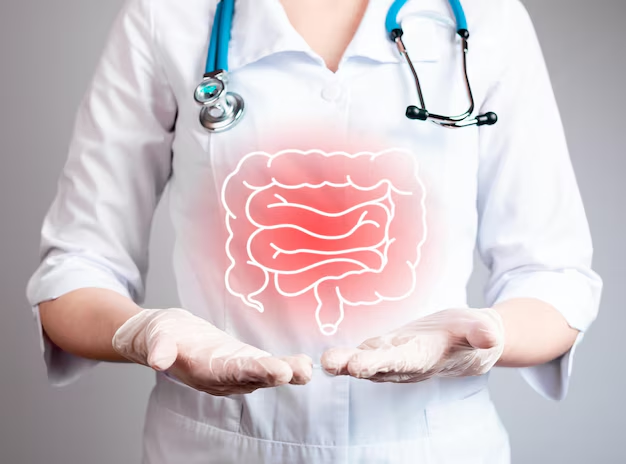
Main Organs of the GI Tract
Mouth
Pharynx
Esophagus
Stomach
Small intestine (duodenum, jejunum, ileum)
Large intestine (colon, rectum)
Anus
Accessory Digestive Organs
Salivary glands
Liver
Gallbladder
Pancreas
Digestive Processes
Digestion involves six main processes:
Ingestion – The process of taking food into the body through the mouth, where digestion begins.
Propulsion – The movement of food through the gastrointestinal tract, which includes voluntary swallowing and the involuntary action of peristalsis.
Mechanical digestion – The physical process of breaking down food into smaller pieces, such as through chewing in the mouth and churning in the stomach.
Chemical digestion – The breakdown of food into its chemical components using digestive enzymes and acids.
Absorption – The process by which nutrients from digested food are transferred from the GI tract into the bloodstream or lymphatic system for use by the body.
Defecation – The final step of digestion, involving the elimination of indigestible substances and waste products from the body in the form of feces.
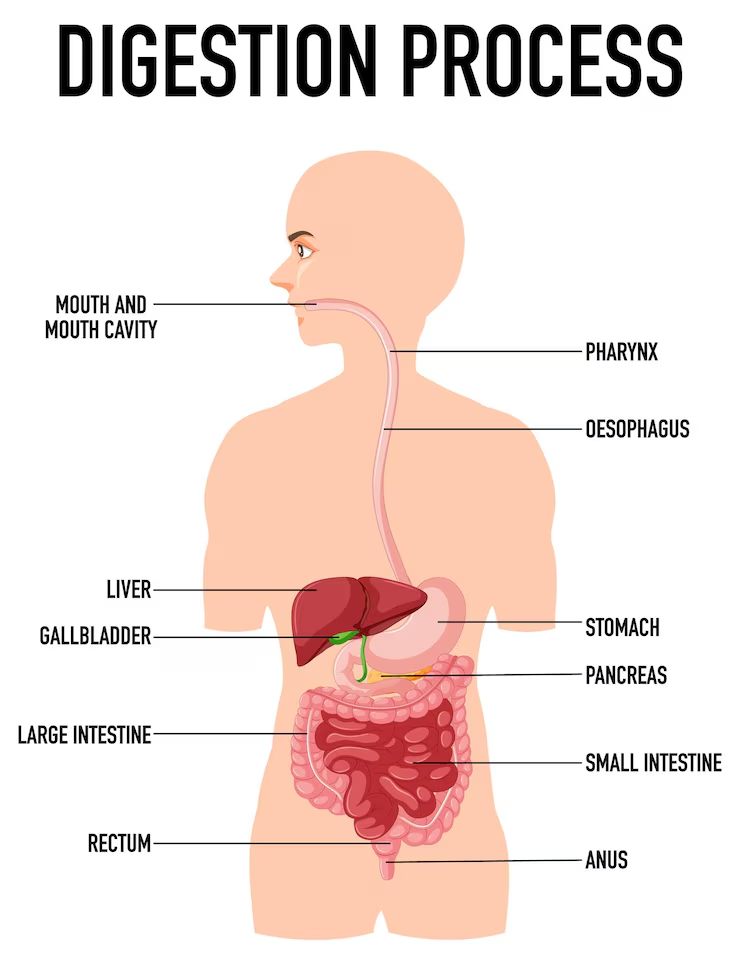
Step-by-Step Journey Through the Digestive System
Mouth (Oral Cavity)
Digestion begins in the mouth, marking the first step of the digestive system. Here, both mechanical and chemical processes start to break down food. Teeth chew the food into smaller pieces, making it easier to swallow, while saliva—produced by the salivary glands—contains enzymes that begin breaking down carbohydrates. This combination of chewing and enzymatic action prepares the food for further digestion. As the chewed food forms a soft mass called a bolus, it is pushed to the back of the mouth and swallowed, starting its journey through the gastrointestinal tract. This early phase is crucial to the entire digestive system.
Teeth break down food into smaller pieces (mastication).
Saliva, secreted by salivary glands, contains the enzyme amylase which begins the digestion of carbohydrates.
The tongue helps mix food with saliva and pushes it toward the pharynx to initiate swallowing.
Pharynx and Esophagus
The pharynx serves as a pathway for food to move from the mouth to the esophagus.
The epiglottis prevents food from entering the windpipe during swallowing.
The esophagus is a muscular tube that moves food to the stomach via peristalsis—a series of wave-like muscle contractions.
Stomach
The stomach is a muscular, J-shaped organ that plays a key role in the digestive system. After food leaves the mouth and travels through the esophagus, it enters the stomach, where it is mixed and broken down further. The stomach walls contract to churn the food, combining it with digestive juices that include hydrochloric acid and enzymes. These substances help break down proteins and kill harmful bacteria. This process turns the food into a semi-liquid mixture called chyme, which is slowly released into the small intestine for further digestion and absorption. The stomach’s role is essential in the digestive system.
It secretes gastric juice, containing hydrochloric acid (HCl) and pepsin, which begin protein digestion.
The stomach churns food into a semi-liquid mixture called chyme.
A thick layer of mucus protects the stomach lining from the acidic environment.
Small Intestine
The small intestine is a crucial part of the digestive system, where most digestion and nutrient absorption take place. After food leaves the stomach, it enters the small intestine as a semi-liquid substance called chyme. Here, digestive enzymes from the pancreas and bile from the liver mix with the chyme to break down fats, proteins, and carbohydrates. The inner walls of the small intestine are lined with tiny finger-like projections called villi, which increase the surface area for absorption. Nutrients pass through these villi into the bloodstream, providing the body with essential fuel and building blocks. This stage is vital in the digestive system.
Duodenum: First part where chyme mixes with bile (from the liver/gallbladder) and pancreatic juice.
Jejunum and Ileum: Sites of nutrient absorption through the intestinal walls.
The inner lining contains villi and microvilli, which increase surface area for absorption.
Liver, Gallbladder, and Pancreas
The liver, gallbladder, and pancreas are vital accessory organs that support the digestive system. The liver produces bile, a substance that helps break down fats in the small intestine. This bile is stored in the gallbladder until it is needed for digestion. When food containing fat enters the small intestine, the gallbladder releases bile to aid in the digestive process. The pancreas also plays a key role by producing enzymes that break down carbohydrates, proteins, and fats, as well as releasing bicarbonate to neutralize stomach acid. These organs work together to ensure the digestive system functions efficiently and effectively.
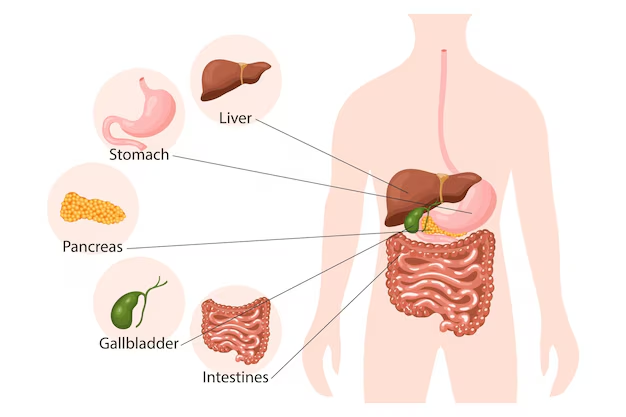
These organs secrete substances into the small intestine to aid digestion:
Liver: Produces bile, which emulsifies fats.
Gallbladder: Stores and releases bile as needed.
Pancreas: Secretes enzymes (lipase, amylase, proteases) and bicarbonate to neutralize stomach acid.
Large Intestine
The large intestine plays an important role in the final stages of the digestive system. After nutrients have been absorbed in the small intestine, the remaining material moves into the large intestine. Here, water, electrolytes like sodium and potassium, and certain vitamins—especially those produced by gut bacteria, such as vitamin K and some B vitamins—are absorbed. This process helps maintain the body’s fluid and mineral balance. The large intestine also compacts the waste into solid form, preparing it for elimination. Though most digestion happens earlier, the large intestine completes the digestive system by managing waste and reclaiming valuable substances.
Colon: Divided into ascending, transverse, descending, and sigmoid sections.
Rectum: Stores feces before elimination.
Anus: Opening through which feces are expelled.
Bacteria in the colon aid digestion by fermenting indigestible substances and producing vitamin K and certain B vitamins.
Digestive Enzymes and Their Functions
| Enzyme | Source | Substrate | Product |
| Amylase | Saliva, Pancreas | Starch | Maltose |
| Pepsin | Stomach | Proteins | Peptides |
| Lipase | Pancreas | Fats | Fatty acids, Glycerol |
| Trypsin, Chymotrypsin | Pancreas | Proteins | Peptides |
| Maltase, Lactase, Sucrase | Small intestine | Disaccharides | Monosaccharides |
Absorption of Nutrients
Different nutrients are absorbed at various stages:
Carbohydrates: Broken into monosaccharides (glucose, fructose) and absorbed in the small intestine.
Proteins: Reduced to amino acids and absorbed in the small intestine.
Fats: Emulsified by bile, broken down by lipases, and absorbed into lymphatic capillaries (lacteals).
Vitamins and minerals: Absorbed in various parts of the small intestine.
Water and electrolytes: Absorbed mostly in the large intestine.
Nervous and Hormonal Regulation
The digestive system is carefully regulated by the enteric nervous system (ENS) and various hormones to ensure smooth and efficient functioning. The ENS, often called the “second brain,” is a network of nerves located in the walls of the gastrointestinal tract. It controls muscle contractions, enzyme secretion, and blood flow within the digestive system. Alongside the ENS, hormones such as gastrin, secretin, and cholecystokinin are released by the stomach and intestines to coordinate digestion. These hormones help regulate stomach acid production, enzyme release, and bile flow. Together, the ENS and hormones maintain balance and coordination throughout the digestive system.
Nervous Control
ENS: The “brain of the gut” controls local functions.
Autonomic Nervous System: Sympathetic and parasympathetic nerves influence motility and secretion.
Hormonal Control
Gastrin: Stimulates gastric acid secretion.
Secretin: Stimulates bicarbonate secretion from the pancreas.
Cholecystokinin (CCK): Stimulates bile release and pancreatic enzyme secretion.
Ghrelin: Stimulates hunger.
Leptin: Signals satiety.
Common Digestive Disorders
Gastroesophageal Reflux Disease (GERD)
This condition occurs when stomach acid frequently flows back into the esophagus, the tube connecting the mouth and stomach. This backflow, known as acid reflux, can cause a burning sensation in the chest (heartburn), irritation, and even damage to the esophageal lining over time.
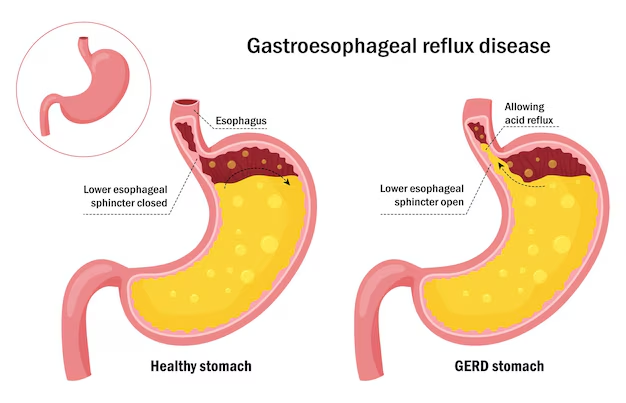
Peptic Ulcers
Peptic ulcers are open sores that develop on the lining of the stomach or the upper part of the small intestine. They are commonly caused by an infection with Helicobacter pylori bacteria or frequent use of nonsteroidal anti-inflammatory drugs (NSAIDs) like ibuprofen or aspirin.
Irritable Bowel Syndrome (IBS)
IBS is a chronic functional disorder of the gastrointestinal tract that causes symptoms such as abdominal pain, bloating, gas, and changes in bowel habits, including constipation, diarrhea, or both. Unlike IBD, IBS does not cause visible inflammation or damage to the intestines.
Inflammatory Bowel Disease (IBD)
IBD refers to chronic inflammatory conditions of the gastrointestinal tract, including Crohn’s disease and ulcerative colitis. These diseases cause persistent inflammation, which may lead to ulcers, bleeding, and long-term damage to the digestive tract, often requiring medical treatment.
Celiac Disease
Celiac disease is an autoimmune condition in which the immune system reacts to gluten—a protein found in wheat, barley, and rye—damaging the lining of the small intestine. This damage impairs nutrient absorption and can cause symptoms like diarrhea, fatigue, and weight loss.
Gallstones
Gallstones are solid particles that form in the gallbladder, often made of cholesterol or bile salts. They can block the normal flow of bile, leading to sharp abdominal pain, nausea, and digestive problems. In severe cases, gallstones may require surgical removal.
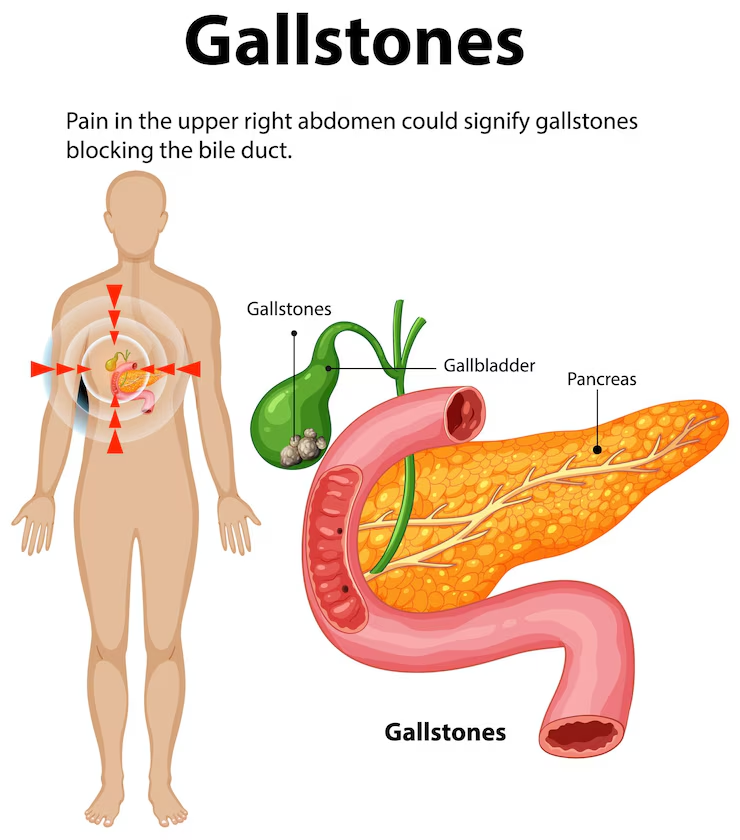
Constipation and Diarrhea
Constipation involves infrequent, hard, or difficult-to-pass bowel movements, often due to slow intestinal movement or low fiber intake. Diarrhea is the frequent passage of loose or watery stools, which may result from infections, food intolerances, or digestive disorders affecting water absorption and motility.
Diagnostic Tests for Digestive Health
Endoscopy: Visual inspection of GI tract using a flexible camera.
Colonoscopy: Inspection of the colon.
Ultrasound/CT Scan: Imaging of internal organs.
Stool Tests: Analyze waste for infection, blood, or digestive issues.
Blood Tests: Check for celiac disease, infections, or liver function.
Tips for Maintaining Digestive Health
Eat a balanced diet rich in fiber, fruits, and vegetables.
Stay hydrated to help move food through the digestive system.
Exercise regularly to promote intestinal motility.
Avoid excessive alcohol, smoking, and processed foods.
Manage stress, which can affect gut function.
Eat slowly and chew thoroughly.
Probiotics can help maintain gut flora balance.
Recent Advances in Digestive Health
Modern medicine has made significant strides:
Gut microbiome research – Ongoing studies are uncovering the crucial role that bacterial populations in the gut play in digestion, immune function, and overall health. These microbial communities help break down food, produce essential nutrients, and protect against harmful pathogens.
Probiotic and prebiotic therapies – The use of probiotics (beneficial live bacteria) and prebiotics (compounds that feed healthy gut bacteria) is becoming more popular as a way to maintain or restore balance in the digestive system, supporting better gut health and digestion.
Fecal microbiota transplants (FMT) – This innovative procedure involves transferring stool from a healthy donor into the digestive tract of a patient, often to treat recurring and severe Clostridium difficile infections that don’t respond to standard treatments.
Minimally invasive surgeries – Advances in surgical techniques now allow for the treatment of serious digestive diseases, such as inflammatory bowel disease or gastrointestinal cancers, through procedures that require smaller incisions, leading to faster recovery and fewer complications.
AI in diagnostics – Artificial intelligence is being increasingly used in digestive health, particularly to improve the accuracy and speed of diagnosing gastrointestinal disorders through imaging, endoscopy, and other advanced diagnostic tools.
Conclusion
The digestive system is a complex network of organs and processes that plays a vital role in maintaining overall health. It is responsible for breaking down food, absorbing essential nutrients, and eliminating waste products. Proper functioning of the digestive system ensures that the body receives the energy and nutrients necessary for growth, repair, and daily activities. A well-maintained digestive system is key to supporting overall wellness and preventing issues such as nutrient deficiencies and waste accumulation.

With advancements in medical science, the management and treatment of digestive disorders have seen significant improvements. From better diagnostic tools to more effective therapies, these innovations have enhanced the quality of life for many individuals suffering from digestive conditions. Understanding the intricacies of the digestive system allows individuals to make informed decisions about their diet, lifestyle, and healthcare, contributing to improved digestive health and overall well-being. Prioritizing digestive health can help reduce the risk of complications and promote a healthier life.
FAQs
Q.1 What is the main function of the digestive system ?
The primary function of the digestive system is to break down food into smaller molecules so that nutrients can be absorbed into the bloodstream and used by the body for energy, growth, and cell repair. It also removes indigestible substances and waste through defecation.
Q.2 How long does the digestive process take ?
The complete digestion process typically takes between 24 to 72 hours, depending on the type of food consumed. Food spends:
A few seconds to minutes in the mouth
2 to 4 hours in the stomach
3 to 5 hours in the small intestine
10 to 59 hours in the large intestine
Q.3 What causes indigestion or acid reflux ?
Indigestion or acid reflux (GERD) can be caused by overeating, consuming spicy or fatty foods, lying down right after eating, obesity, or weakened esophageal muscles. It results in stomach acid flowing back into the esophagus, causing discomfort or a burning sensation (heartburn).
Q.4 Why is fiber important for digestion ?
Dietary fiber adds bulk to the stool and helps it pass more easily through the digestive tract, preventing constipation. It also supports healthy gut bacteria and may reduce the risk of digestive disorders like diverticulitis, hemorrhoids, and colorectal cancer.
Q.5 What are probiotics, and how do they help the digestive system ?
Probiotics are beneficial bacteria that support gut health. They help balance the gut microbiome, improve digestion, strengthen the immune system, and may reduce symptoms of digestive disorders like IBS, diarrhea, and bloating.



